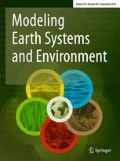Abstract
Due to permanent dry conditions in arid land basins, channels experience a great quantity of water loss during the runoff process. The objective of this study is to quantify and delineate the spatial variability of channel losses over the contributing area of the upstream side of Wadi Al-Lith, in the western region of Saudi Arabia, by using Muskingum–Cunge flow routing method. HEC-HMS model was used here to simulate rainfall-runoff relationship, to route flood hydrograph, and to determine losses in the channel network of the basin. The required geomorphological parameters such as channel’s geometry, roughness coefficient, and slopes obtained from GIS and field measurements. The model was calibrated and validated on real rainfall-runoff events and the optimized parameters were generalized. Results showed that both calibrated and validated hydrographs are in good agreement with observed hydrographs. Channel constituted the highest losses from the total rainfall and that these losses increased as the basin area increased and the slope decreased. The maximum percentage loss was 47.3% and the minimum percentage loss was 2.1%. Although these losses are from surface water, at the same time these losses are considered as gains to the subsurface storage. Therefore, such losses and gains should be considered in the water resources planning and management formulation.







Similar content being viewed by others
References
Abida H, Ellouze M, Mahjoub MR (2005) Flood routing of regulated flows in Medjerda River. Tunis J Hydroinformatics 7:209–216
Al-Ahmadi FS (2005) Rainfall-runoff modeling in arid regions using geographic information systems and remote sensing: case study; western region of Saudi Arabia. King Abdulaziz University, Jeddah
Choudhury P, Shrivastava RK, Narulkar SM (2002) Flood routing in river networks using equivalent Muskingum inflow. J Hydrol Eng 7:413–419
Cunge JA (1969) On the subject of a flood propagation computation method (Musklngum method). J Hydraul Res 7:205–230
Dastorani MT, Khodaparast R, Talebi A, Vafakhah M, Dashti J (2011) Determination of the ability of HEC-HMS Model components in rainfall-run-off simulation research. J Environ Sci 5:790
Delphi M, Shooshtari MM, Zadeh HH (2010) Application of Diffusion Wave Method for Flood Routing in Karun River. Int J Environ Sci Dev 1:432
Fenton JD (2010) Accuracy of Muskingum-Cunge flood routing. Technical report, Alternative Hydraulics, Institute of Hydraulic and Water Resources Engineering. http://johndfenton.com/Papers/03-Accuracy-of-Muskingum-Cunge-flood-routing.pdf
Fread D (1983) A unified coefficient routing model. In: Paper present at seminar, Department of Civil Engineering, Pa. State University, University Park
Haktanir T, Ozmen H (1997) Comparison of hydraulic and hydrologic routing on three long reservoirs. J Hydraul Eng 123:153–156
Hughes DA (2008) Modelling semi-arid and arid hydrology and water resources: the southern Africa experience. In: Wheater H, Sorooshian S, Sharma KD (eds) Hydrological modelling in arid and semi-arid areas. Cambridge University Press, Cambridge, pp 29–40
Ivkovic KM (2009) A top–down approach to characterise aquifer–river interaction processes. J Hydrol 365:145–155
Kafle T, Hazarika M, Karki S, Shrestha R, Sharma S, Samarakoon L (2007) Basin scale rainfall-runoff modelling for flood forecasts. In: Proceedings of the 5th Annual Mekong Flood Forum, Ho Chi Minh City, Vietnam, pp 17–18
Lange J (2005) Dynamics of transmission losses in a large arid stream channel. J Hydrol 306:112–126
Lawyer (1964) Flood routing. In: US Army Corps of Engineers (ed) Handbook of applied hydrology, Sect. 25-II river division. US Army Corps of Engineers, Ohio, pp 35–58
McCarthy GT (1939) The unit hydrograph and flood routing. US Corps Engrs Office, Providence, RI, USA
Merkel WH (2002) Muskingum-Cunge flood routing procedure in NRCS hydrologic models. In: Second Fed. Interag. Hydrol. Model. Conf., Las Vegas, Nevada
Merz R, Blöschl G (2009) A regional analysis of event runoff coefficients with respect to climate and catchment characteristics in Austria. Water Resour Res 45:W01405. doi:10.1029/2008WR007163
Micheal A, Ojha T (2006) Principles of agricultural engineering. Jain Bros
NERC (1975) Flood-routing studies. Report No V–III. Natural Environment Research Council, London
Radmanesh F, Hemat JP, Behnia A, Khond A, Mohamad BA (2006) Calibration and assessment of HEC-HMS model in Roodzard watershed. In: 17 th international conference of river engineering, university of Shahid Chamran, Ahva
Renard K, Nichols M, Woolhiser D, Osborn H (2008) A brief background on the US Department of Agriculture Agricultural Research Service Walnut Gulch Experimental Watershed. Water Resour Res 44
Shaw EM (1994) Hydrologyin practice. Chapman and Hall, London
Sophocleous M (2002) Interactions between groundwater and surface water: the state of the science. Hydrogeol J 10:52–67
Tewolde MH, Smithers J (2006) Flood routing in ungauged catchments using Muskingum methods. Water SA 32:379–388
Wheater HS (2008) Modelling hydrological processes in arid and semi-arid areas: an introduction. In: Wheater H, Sorooshian S, Sharma KD (eds) Hydrological modelling in arid and semi-arid areas. Cambridge University Press, Cambridge, pp 1–20
Acknowledgements
This project was funded by the National Plan for Science, Technology and Innovation (MAARIFAH)—King Abdulaziz City for Science and Technology - the Kingdom of Saudi Arabia—award number (11-WAT1999-03). The authors also, acknowledge with thanks Science and Technology Unit, King Abdulaziz University for technical support.
Author information
Authors and Affiliations
Corresponding author
Rights and permissions
About this article
Cite this article
Rahman, K.U., Balkhair, K.S., Almazroui, M. et al. Sub-catchments flow losses computation using Muskingum–Cunge routing method and HEC-HMS GIS based techniques, case study of Wadi Al-Lith, Saudi Arabia. Model. Earth Syst. Environ. 3, 4 (2017). https://doi.org/10.1007/s40808-017-0268-1
Received:
Accepted:
Published:
DOI: https://doi.org/10.1007/s40808-017-0268-1




